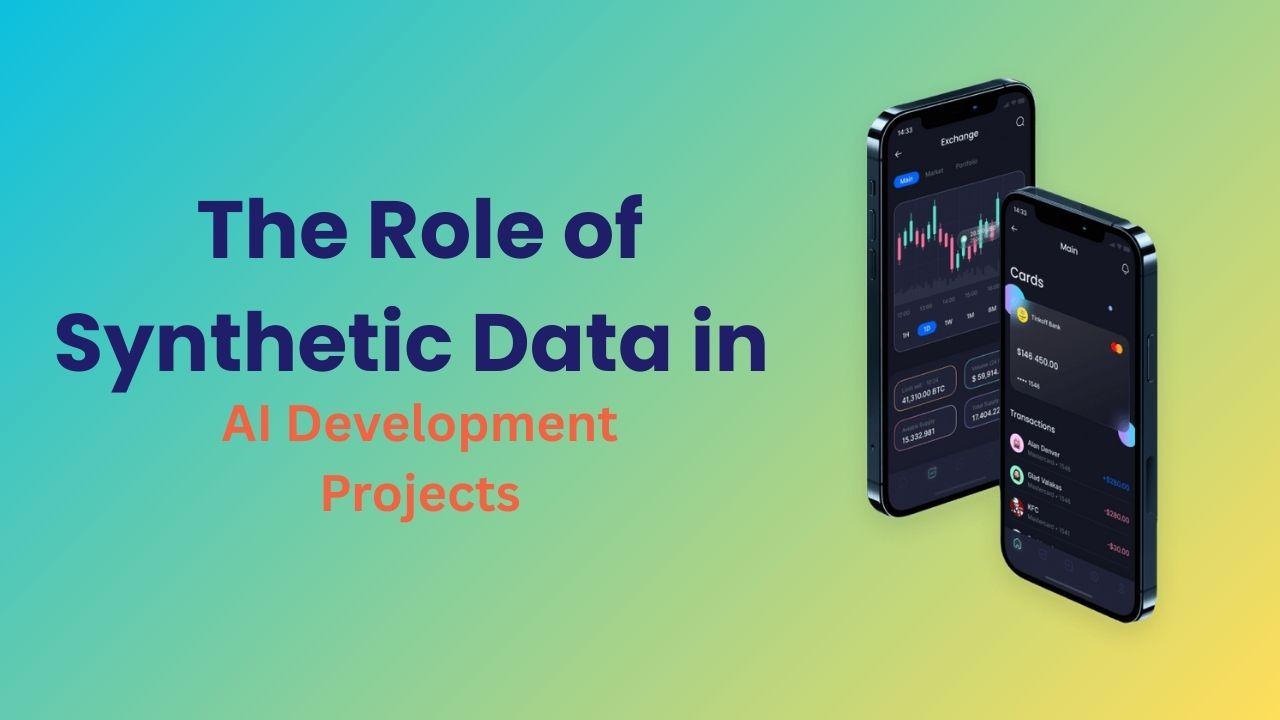The Role of Synthetic Data in AI Development Projects
Artificial intelligence (AI) is transforming industries at a breathtaking pace, with applications ranging from autonomous vehicles and voice assistants to fraud detection and personalized recommendations. However, building robust and accurate AI models requires vast amounts of data—a resource that is not always readily available or ethically feasible to collect. This is where synthetic data comes into play. For any artificial intelligence development company, leveraging synthetic data has become a vital strategy for overcoming data scarcity and improving model performance while managing development costs.
In this comprehensive blog, we’ll explore what synthetic data is, how it supports AI development, its benefits and challenges, and its growing role in shaping the future of intelligent applications—including mobile solutions like those developed through android app development services.
What is Synthetic Data?
Synthetic data is artificially generated information that mimics real-world data. It is created using algorithms and simulation techniques rather than being collected from actual events or real-life sources. This data can represent images, video, text, audio, or tabular formats and is designed to resemble the statistical properties of real data closely.
Unlike anonymized or aggregated datasets, synthetic data is created from scratch, offering unique advantages in terms of privacy, scalability, and flexibility. It is widely used in training machine learning (ML) and deep learning (DL) models, particularly in scenarios where real data is hard to obtain, expensive, or sensitive.
How Synthetic Data Supports AI Development
AI models, especially those using deep learning techniques, require massive datasets to function effectively. Unfortunately, obtaining labeled and high-quality real-world data can be time-consuming, costly, or legally complicated. Here’s how synthetic data supports AI development projects:
1. Data Availability
In domains such as healthcare, finance, and autonomous driving, acquiring large and diverse datasets is often hindered by privacy laws or logistical constraints. Synthetic data generation allows companies to simulate varied scenarios without the need for real data collection.
2. Faster Training and Iteration
Synthetic data can be produced in large volumes with predefined annotations, significantly reducing the time and effort needed for manual labeling. This expedites the model training and validation processes, leading to quicker AI prototyping and deployment.
3. Improved Data Diversity
Synthetic data allows AI developers to simulate rare or edge-case scenarios that may be difficult to capture in real-life datasets. For example, simulating low-light or unusual traffic conditions can help autonomous vehicle systems better generalize to real-world unpredictability.
4. Privacy Compliance
Using real data often involves compliance with privacy regulations like GDPR or HIPAA. Since synthetic data is not tied to any real individual, it offers a privacy-preserving alternative that still enables AI development, especially for sensitive use cases.
5. Lower AI Development Cost
Collecting and labeling real-world data can be prohibitively expensive. Synthetic data offers a cost-effective solution by reducing the need for large-scale manual data collection efforts. For many businesses, especially startups and mid-sized companies, this contributes significantly to reducing the overall AI development cost.
Types of Synthetic Data
-
Fully Synthetic Data – Created entirely by algorithms with no reference to real data. Commonly used in simulated environments or virtual worlds.
-
Partially Synthetic Data – A combination of real and artificially generated data. Useful when preserving certain real-world data traits while adding variability.
-
Simulated Data – Generated using mathematical models, often used in physics-based or system-level simulations, such as weather modeling or autonomous driving.
Real-World Applications of Synthetic Data in AI Projects
1. Healthcare
Synthetic data is increasingly used to simulate patient records, medical imaging, and clinical trials. This enables healthcare organizations to build predictive models while preserving patient privacy. For instance, a synthetic dataset of MRI scans can be used to train an AI model to detect brain tumors without using any real patient data.
2. Finance
Financial institutions use synthetic transaction data to train fraud detection systems. This helps simulate a wide range of scenarios, from typical user behavior to fraudulent patterns, without compromising actual user information.
3. Autonomous Vehicles
Companies like Tesla and Waymo use simulated driving environments to generate data that trains AI to respond to complex and rare road situations. This reduces the dependency on real-world driving data and accelerates development.
4. Retail and E-commerce
AI systems in e-commerce use synthetic customer data to test recommendation engines, simulate shopping behavior, and optimize user experiences. This is especially useful for android app development services that cater to retail clients looking to personalize their mobile shopping apps.
5. Cybersecurity
Cybersecurity firms use synthetic data to mimic malware behaviors, phishing attacks, and network intrusions. This trains AI systems to detect and respond to threats that may not yet exist in real environments.
Benefits of Using Synthetic Data
1. Cost Efficiency
The ability to generate data on-demand reduces the need for large, expensive data collection projects, thereby lowering AI development cost significantly.
2. Scalability
Synthetic datasets can be scaled quickly to match the needs of AI training. This helps artificial intelligence development companies ramp up their capabilities without facing data bottlenecks.
3. Enhanced Model Performance
Synthetic data can improve model robustness by exposing AI systems to a broader set of scenarios. This leads to better generalization in real-world applications.
4. Bias Mitigation
Synthetic data allows developers to balance underrepresented classes in training datasets, helping reduce model bias and improving fairness.
5. Experimentation Freedom
Developers can test multiple AI models under various scenarios without worrying about privacy or ethical concerns, fostering innovation.
Challenges and Limitations
Despite its advantages, synthetic data comes with its own set of challenges:
-
Realism – Poorly generated synthetic data may lack the fidelity of real-world data, leading to underperforming AI models.
-
Validation – It's essential to validate the quality and usefulness of synthetic data to ensure it contributes positively to model performance.
-
Tooling and Expertise – Generating high-quality synthetic data requires specialized tools and expertise, which not all development teams possess.
-
Domain-Specific Limitations – In some fields, it may be hard to simulate the complexity of real-world phenomena accurately.
Tools and Techniques for Synthetic Data Generation
Several tools and techniques exist for generating synthetic data:
-
GANs (Generative Adversarial Networks) – These deep learning models are widely used to generate realistic synthetic images, audio, and text.
-
Simulators – Platforms like CARLA (for autonomous driving) and AirSim (for aerial robots) create highly realistic environments.
-
Data Augmentation – Simple techniques like flipping, cropping, or rotating images to expand datasets.
-
Statistical Modeling – Tools like the Synthetic Data Vault (SDV) generate tabular data based on statistical distributions.
The Future of Synthetic Data in AI Development
The demand for synthetic data is expected to grow exponentially as AI becomes more embedded in everyday technology. From training self-learning algorithms to enhancing customer experiences in mobile apps, synthetic data offers a scalable and ethical way forward.
For instance, artificial intelligence development companies working with android app development services are increasingly using synthetic data to simulate user interactions, predict behaviors, and refine user interfaces. This enables them to deliver smarter, more intuitive mobile apps at a fraction of the traditional development cost.
Moreover, regulatory environments are evolving to support the use of synthetic data, recognizing its potential in safeguarding privacy while fostering innovation. As tooling improves and adoption widens, synthetic data will likely become a cornerstone of AI development strategies across sectors.
Conclusion
Synthetic data is revolutionizing the way AI models are trained and deployed. By enabling access to abundant, diverse, and privacy-compliant datasets, it plays a pivotal role in accelerating AI innovation while minimizing risks and reducing development costs. Whether you're a startup exploring Android app development services or an established artificial intelligence development company, embracing synthetic data could be the key to unlocking your next breakthrough.
In an era where data is the new oil, synthetic data might just be the refinery that transforms raw potential into real-world AI solutions. And as AI development cost continues to be a crucial factor for businesses, synthetic data emerges as a game-changing tool for building efficient, ethical, and scalable intelligent systems.



